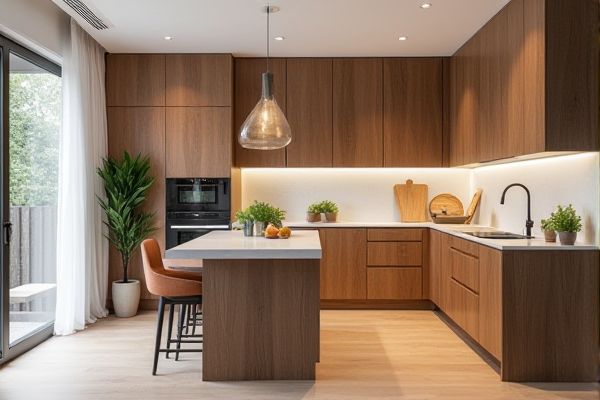
Wood cabinetry offers natural durability and timeless beauty, while laminate cabinetry provides a cost-effective, low-maintenance alternative with a wide variety of finishes. Discover which option best suits your style and budget by reading the rest of the article.
Table of Comparison
| Feature | Wood Cabinetry | Laminate Cabinetry |
|---|---|---|
| Material | Solid hardwood or engineered wood | Composite wood covered with plastic laminate |
| Durability | High, strong and long-lasting | Moderate, resistant to scratches but can chip |
| Maintenance | Requires periodic sealing/polishing | Easy to clean with mild detergent |
| Cost | Higher initial investment | More affordable and budget-friendly |
| Appearance | Natural grain, warm and classic look | Wide range of colors and finishes, modern look |
| Customization | Highly customizable with stains and finishes | Limited customization, predetermined finishes |
| Moisture Resistance | Prone to warping if not sealed properly | Good resistance to moisture and humidity |
| Environmental Impact | Biodegradable, renewable resource | Contains plastics, less eco-friendly |
Introduction: Choosing Between Wood and Laminate Cabinetry
Wood cabinetry offers timeless beauty, natural grain patterns, and exceptional durability, making it a popular choice for high-end kitchen designs. Laminate cabinetry provides a budget-friendly alternative with a wide range of colors and finishes, offering easy maintenance and resistance to scratches and moisture. Your decision should consider factors like style preference, budget, and long-term durability to select the best cabinetry material for your home.
Aesthetic Differences: Wood vs Laminate Cabinetry
Wood cabinetry offers a natural grain pattern and rich texture that provide warmth and timeless elegance, with variations in color and knots enhancing its unique character. Laminate cabinetry features a smooth, uniform surface available in a wide range of colors and finishes, including matte, high-gloss, and wood-look patterns that mimic the appearance of real wood. While wood presents authentic depth and tactile appeal, laminate excels in consistent color retention and resistance to scratches and stains, catering to modern design preferences.
Durability and Longevity Comparison
Wood cabinetry offers superior durability and longevity, often lasting decades with proper care due to its dense, solid structure and resistance to wear. Laminate cabinetry, while more affordable and scratch-resistant, typically has a shorter lifespan because its core materials can delaminate or warp over time, especially in humid environments. Choosing wood ensures lasting quality and investment value, preserving your kitchen's aesthetic and functionality for years to come.
Cost Analysis: Wood Cabinets vs Laminate Cabinets
Wood cabinets generally cost between $150 to $500 per linear foot, reflecting higher material and craftsmanship expenses, while laminate cabinets typically range from $80 to $300 per linear foot due to lower production and material costs. The long-term investment in wood cabinets offers durability and the potential for refinishing, often justifying the initial higher cost, whereas laminate cabinets provide a budget-friendly option with easier installation but may require replacement sooner. Evaluating the overall cost-effectiveness depends on factors such as kitchen size, desired longevity, and maintenance preferences.
Maintenance and Cleaning Requirements
Wood cabinetry requires regular polishing and gentle cleaning with mild soap to preserve its natural grain and prevent damage from moisture. Laminate cabinetry offers low-maintenance benefits, needing only a damp cloth and mild detergent to remove stains without worrying about warping or fading. Your choice depends on how much effort you want to invest in upkeep to maintain the cabinetry's appearance over time.
Environmental Impact: Sustainability Factors
Wood cabinetry made from sustainably harvested hardwoods is a renewable resource that supports forest regeneration and biodiversity, while laminate cabinetry typically relies on synthetic materials like melamine and particleboard, which are less biodegradable and often sourced from non-renewable petrochemicals. Manufacturing processes for wood cabinetry generally have a lower carbon footprint due to the natural growth cycle of trees absorbing CO2, whereas laminate production involves higher energy consumption and emissions from petrochemical processing. Recyclability and durability favor wood cabinetry as it can be refurbished or repurposed, reducing landfill waste compared to laminate finishes that deteriorate more quickly and are harder to recycle.
Customization and Design Flexibility
Wood cabinetry offers unparalleled customization and design flexibility, allowing for intricate carvings, varied wood grain patterns, and bespoke finishes that enhance your kitchen's unique character. Laminate cabinetry provides a wide range of color options and textures but is limited in its ability to mimic the natural depth and variation of wood, restricting some design possibilities. Choosing wood ensures a personalized, high-end aesthetic, while laminate suits budget-conscious projects seeking diverse styles with easier maintenance.
Installation Process: What to Expect
Wood cabinetry installation involves precise measurements and skilled craftsmanship to ensure seamless fitting, often requiring professional expertise due to the material's weight and natural variations. Laminate cabinetry offers a more straightforward installation process, featuring pre-fabricated panels that are lighter and easier to handle, making it a popular choice for DIY projects. Both materials require proper alignment and secure mounting, but laminate typically allows for quicker setup with fewer adjustments needed during installation.
Common Issues and Repair Solutions
Wood cabinetry often faces issues like warping, cracking, and water damage due to its natural properties, requiring repairs such as sanding, refinishing, or replacing damaged panels. Laminate cabinetry is prone to chipping, peeling, and bubbling, typically addressed by using adhesive, edge banding replacements, or patch kits. Proper maintenance and timely repairs extend the lifespan of both wood and laminate cabinets, ensuring lasting durability and aesthetic appeal.
Which is Best for Your Home: Wood or Laminate Cabinetry?
Wood cabinetry offers unmatched durability, natural beauty, and the ability to be refinished, making it ideal for homeowners seeking long-term investment and classic appeal. Laminate cabinetry provides a cost-effective, low-maintenance option with a wide range of colors and patterns, perfect for modern aesthetics and busy lifestyles. Evaluating your budget, design preferences, and maintenance expectations will help determine whether wood or laminate cabinetry best suits your home's needs.
 homyna.com
homyna.com